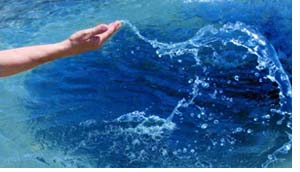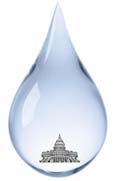Water 2.0 New Year’s Resolutions 2019
Posted on January 9th, 2019 | No Comments »
Happy New Year! Every year many of us create a new set of resolutions: I will exercise more, change my diet and focus on my health. But what if we resolved to change our planet? Let’s add saving water to our list of resolutions.

The topic of water in America has increased during the last 10 years. Water conservation is “in” due to numerous water crises in the United States. Every American citizen can participate in water conservation. If we each commit to small conservation efforts, then we can have large impacts for the future of our water supply. This year we have created 10 resolutions to put us one step further towards saving our water.

1. Become a Water Infrastructure Advocate
In your community, attempt to raise the consciousness of individuals in regard to America’s water infrastructure issues. Please call your Senator and Congressional Representative and tell them we must repair America’s water infrastructure. It is important to understand public policy and proposed Congressional legislation in regard to water infrastructure. The Green New Deal is a movement that is going to propose infrastructure legislation, which includes water infrastructure.
A Green New Deal for cars would be easier than you think
The Week
House energy panel to dedicate first hearing to climate change
The Hill
It is important to understand the role of educating the community in regard to the water ecosystem. Dr. Kenneth E. Russell, VP Digital Transformation & CIO of Pfeiffer University presented at our Water 2.0 Conference the importance of higher education in driving new innovation.
 2. Become a Water Evangelist
2. Become a Water Evangelist
Read as many articles as you can about the water industry. In 2018 Water 2.0 had two fabulous conferences. Alan Hinchman, Chief Innovation Officer of GrayMatter Systems gave an excellent presentation on Water Industry innovation at our Fall 2018 event: Innovation as a Service
3. Cut back on drinking bottled water
Sadly, 5 out of 6 empty plastic water bottles are not recycled. Below you will find some articles illuminating this subject.
Study Finds Rising Levels of Plastics in Oceans
New York Times
Plastic Garbage Patch Bigger than Mexico found in Pacific
National Geographic
The Great Pacific Garbage Patch, full of ocean plastic, keeps growing
NBC
4. Reuse water
Reusing water at home is easier than you might think; all it takes is an awareness of how and when you are using water. For example, use the water from the dehumidifier to water your house plants. Consciously ask yourself where water can be used before you pour it down the drain.
5. Buy recycled goods
One of the best ways to conserve water is to buy recycled goods, as well as, recycling your own goods. It takes about 100 gallons of water to grow and process a single pound of cotton. By recycling, we can make that number stretch over multiple items.
6. Fix leaky faucets
Leaky faucets that drip at 1 drop per second can waste up to 2,700 gallons of water each year. Make 2019 the year we put that number to better use.
7. Replace old toilets with newer, updated models.
Older toilets can use three gallons of clean water with every flush, while newer toilets use as little as one gallon. This small change will help to reduce water waste in your household. It makes a difference. My water bill decreased after replacing 3 toilets.
8. Shorten the length of your shower
Reducing your shower time from ten minutes to five minutes could save an average of about six gallons of water per day. I convinced my daughter when she was 18 to reduce her shower time from 30 minutes to 20 minutes. Trust me, it was not easy! Now she is 21, in college and has reduced her shower time to 10 minutes.
9. Turn off the tap while brushing your teeth
Running the tap while you brush your teeth can waste up to 4 gallons of water each day. In 2019, resolve to turn the faucet off while cleaning your pearly whites.
10. Run your washing machine and dishwasher when they are full
It is easy to get in the habit of starting to clean clothes or dishes when there are only a few items. By waiting until you have a full load you could save up to 3,400 gallons of water per year. Holding off until you have a full load also has the added benefit of saving you 25% to 50% of the energy of small loads.
————————————————–
EVENTS
Water 2.0/NanoBCA Webinar
Leadership. If you don’t know your style, it WILL break you.
Date: Wednesday, Jan 9, 2019
Time: 2:00 PM – 3:00 PM ET
Please join my meeting from your computer, tablet or smartphone.
https://global.gotomeeting.com/join/229274829
You can also dial in using your phone.
United States: +1 (872) 240-3212
Access Code: 229-274-829
————————————————–
Water Innovations Alliance Foundation (WIAF) Individual Membership
In 2018 the Water Innovations Alliance Foundation completed two successful Water 2.0 events.
Water 2.0 Conference: Digitally Connecting the Water Industry
November 8, 2018 – Misenheimer NC
Water 2.0 Conference: Digitally Connecting the Water Industry
May 17, 2018 – Raleigh-Durham NC
These events focused on the use of data analytics, software, cyber security for water utilities and industrial water users. Participants included water and energy industry authorities, utilities professionals and representatives from the EPA.
CLICK HERE to become a WIAF INDIVIDUAL MEMBER
Annual Individual Membership fee $250
The Water Innovations Alliance Foundation is a 501(c)(3) non-profit organization, your contribution is tax-deductible.
Features of WIAF Individual Membership include:
– Invitation to participate on our monthly conference calls
– Networking Opportunity – access to members who have provided their email addresses for contact from other WIAF Members
Our members value the monthly conference calls and annual events. These are the two major features of WIAF membership.
————————————————–
Once again, we encourage you to embrace the above mentioned water resolutions for 2019.




